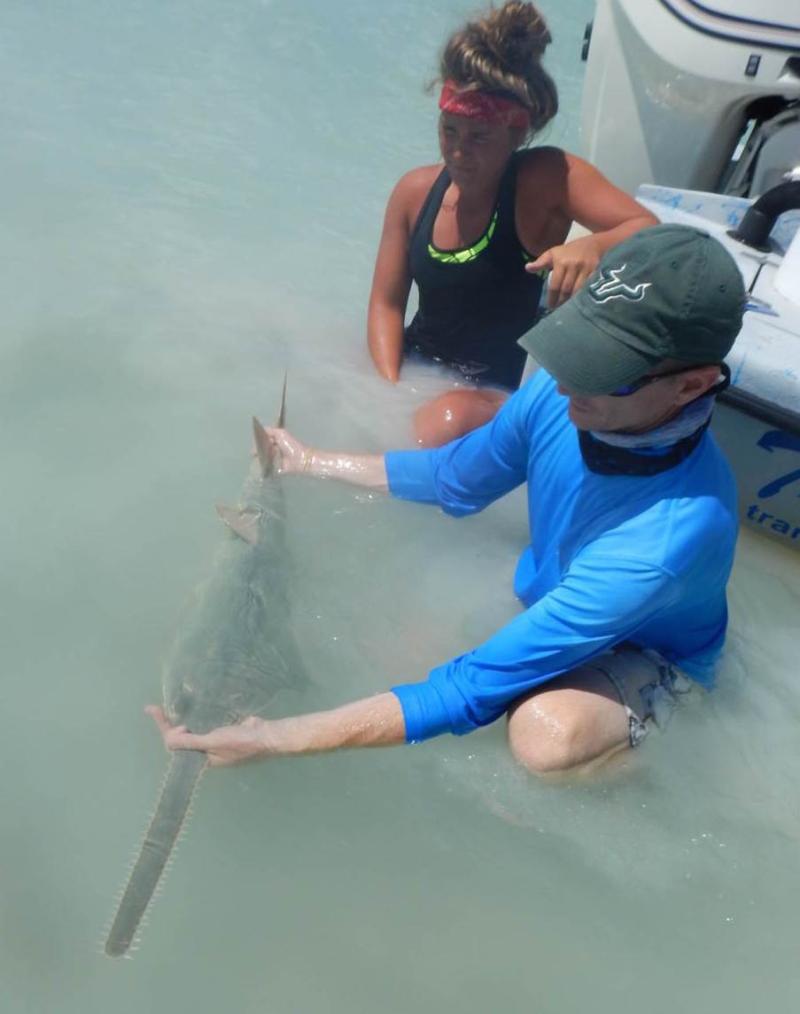NOAA biologists join partners worldwide to celebrate the second International Sawfish Day on October 17, 2018. This annual event was created in partnership with the Sawfish Conservation Society and the European and American Associations of Zoos and Aquariums.
This year marks the 15th anniversary of sawfish being listed under the Endangered Species Act. Over the past 15 years much has been done to recover this iconic species.
One of those people working hard to recover the species is NOAA biologist, Adam Brame. We asked Adam to share more on how he got into marine biology as a career and why he chose to work with this unique species.
Why study sawfish?
Adam: Sawfish have such a distinctive look with a shark-like back half, a ray-like middle, and a rostrum up front that resembles a hedge trimmer, who wouldn't want to fulfill their curiosity and learn more about these fish? Then add in their rarity as a critically endangered species and these fish become even more appealing. Sawfish are analogous to rare gemstones or cultural artifacts (short supply and very unique) and getting the opportunity to study anything so rare is always exciting. Learning more about their ecology and using that knowledge to conserve this endangered species through proper management is very rewarding.
What is your educational background?
Adam: Growing up with a passion for fishing and the outdoors, I entered college to study biology and slowly honed in on the marine environment. I focused my studies towards marine biology and took elective classes such as ichthyology, marine invertebrate zoology, marine biology, marine botany, and marine ecology. After completing an undergraduate degree and starting a career as a fish biologist, I returned to school and acquired a graduate degree in biological oceanography. I was lucky to work as a field biologist studying a variety of different marine organisms (fish, sea turtles, corals) and environments (estuaries, wetlands, coral reefs) before becoming a resource manager.

What advice would you give people wanting to go into this field?
Adam: I always encourage young scientists and students to seize every opportunity, try new things, and meet new people. Each experience expands your skill-set, social network, and future opportunities.
Tell us about an interesting encounter with a sawfish.
Adam: Smalltooth sawfish range in size from about 2 feet in length as newborns to about 16 feet as adults. I've been lucky enough to witness both of these size classes in the wild while conducting research, and the experience of seeing these gentle creatures is absolutely amazing. Yet, catching both male and female adult sawfish with fresh mating scars was the most memorable research experience to date. Up until those captures we had been unsure of where mating was occurring so it was a rewarding day when we made that discovery.

What is the most important thing about sawfish that you want people to know?
Adam: All five species of sawfish are in peril of extinction as a result of human activities, but there is optimism that we can save them. The United States population of smalltooth sawfish declined dramatically due to mortality in commercial and recreational fisheries, but we've been able to minimize these threats more recently. It is imperative however, that anglers follow safe release guidance to quickly and safely release sawfish after any incidental capture. These are long-lived species and recovery is going to take decades but with the help of outdoor enthusiasts I'm confident in their recovery.
Learn more about sawfish:



